by Federico Giannini, Ilaria Baratta , published on 11/08/2020
Categories: Works and artists
/ Disclaimer
The "Turkish Slave" is one of Parmigianino's most famous works, and certainly his most famous portrait. But who depicts this marvelous girl dressed in luxurious robes?
She is not a slave, nor is she Turkish: yet, this wonderful young woman with brown hair and green eyes, with her fine arched eyebrows, coquettish gaze and flushed cheeks, has gone down in art history as the Turkish Slave. And it is one of the best-known masterpieces by Parmigianino (Francesco Mazzola; Parma, 1503 - Casalmaggiore, 1540), and is now in the National Gallery of Parma, part of the Pilotta complex. We have, of this painting, no records coeval with the painter: the earliest attestation goes back to an inventory of the collections of Cardinal Leopoldo de’ Medici in 1675 (“portrait of a young woman with turban on her head, without vein, with her left hand holds a white plume, by the hand of Parmigianino”), while the name “Turkish Slave” is found in an annotation in the inventory of the Medici Guardaroba where it mentions “a panel painting 11/6 fathoms high, 18 soldi wide, painted there by the hand of Parmigianino, half-figure, the portrait of a Turkish slave with turban on her head and rosta in her hand of white feathers, with carved and all-gilt ornamentation.” So we know that, at some point in history, the work entered the Medici collections, although we do not know when, nor do we have any idea how it made its way into the collection. We do, however, know very well the circumstances under which the Turkish Slave left Florence to arrive in Emilia: it was 1928, and the Uffizi Gallery, where the painting was kept, exchanged Parmigianino’s panel for two works that were formerly in the collections of the Bourbons of Parma but had an ancient Florentine provenance, namely the San Zanobi attributed to the Master of Bigallo (formerly in Florence Cathedral) and the Redeemer’s dossal by Meliore di Jacopo. As part of the deal, the Parma Gallery also obtained two works by as many 18th-century artists, Giuseppe Baldrighi and Hubert Robert.
Critics have never questioned the authorship of The Turkish Slave, however much the work did not look the way we see it today in the past. Until the 1960s, in fact, the portrait was obscured, covered by a layer of overlapping varnish, which had blackened, extinguishing the brilliance of Parmigianino’s colors (the background itself, originally a soft and delicate green as we see it today, had been darkened, probably to update the work to the new directions of taste: the blackness of the “updated” background had also affected the cheeks of the young woman). When the cleaning carried out by restorer Renato Pasqui revealed the vividness of the young girl and the typical intensity of Parmigianino’s colors, it was possible without hesitation to refer the work, with almost total certainty, to Francesco Mazzola. The intervention was not an easy task: if you look carefully at the painting, close up, you will notice a very slight dark shading on the outermost part of the cheeks. But in the end, Parmigianino’s color character emerged: “a painting,” wrote Augusta Ghidiglia Quintavalle commenting on the results of the restoration, “marked on the bright and exaltedly contrasted colors, with iridescence in the robes and violent lights in the pink flesh.”
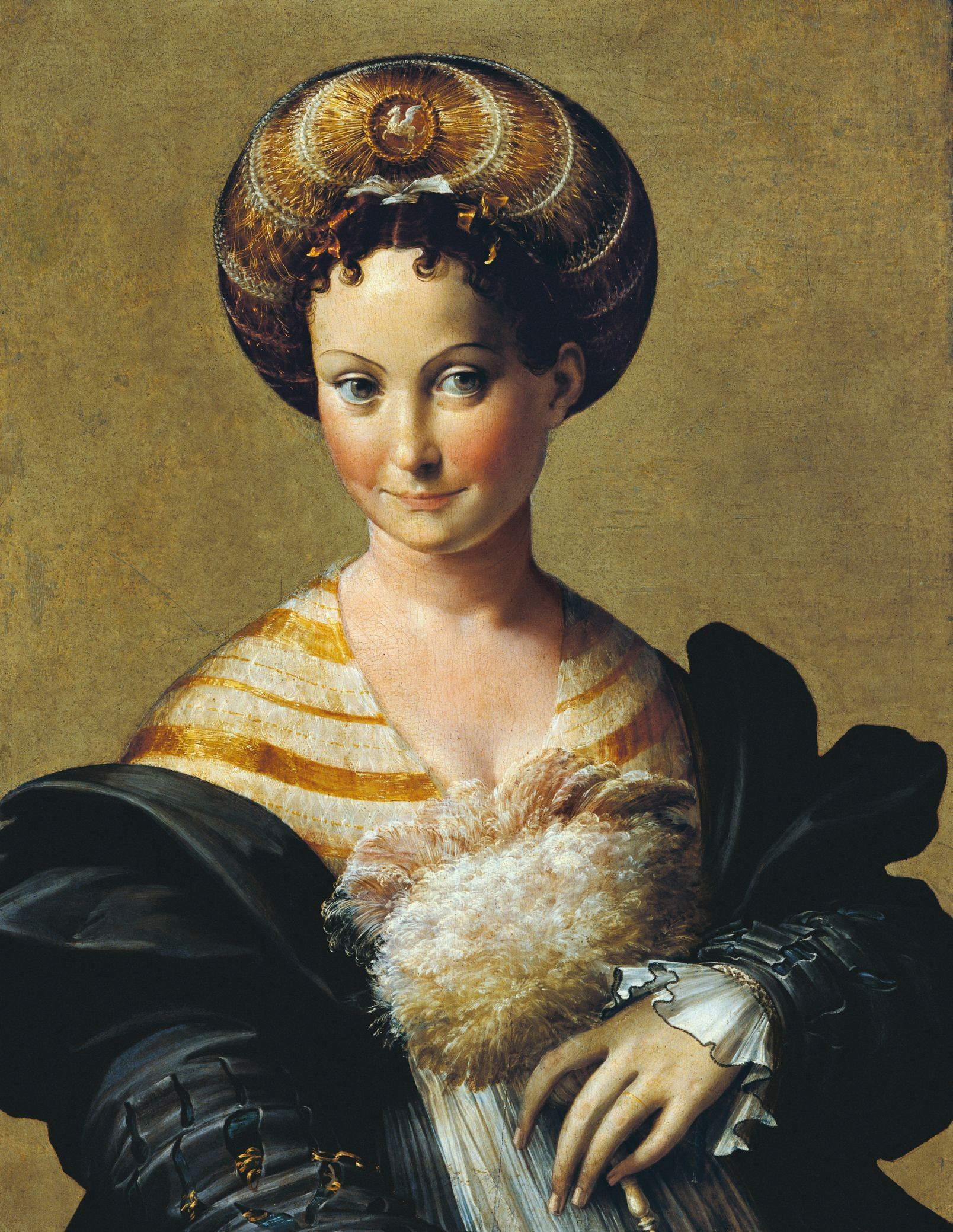 |
| Parmigianino, Turkish Slave Girl (c. 1530-1534; oil on panel, 68 x 53 cm; Parma, Galleria Nazionale) |
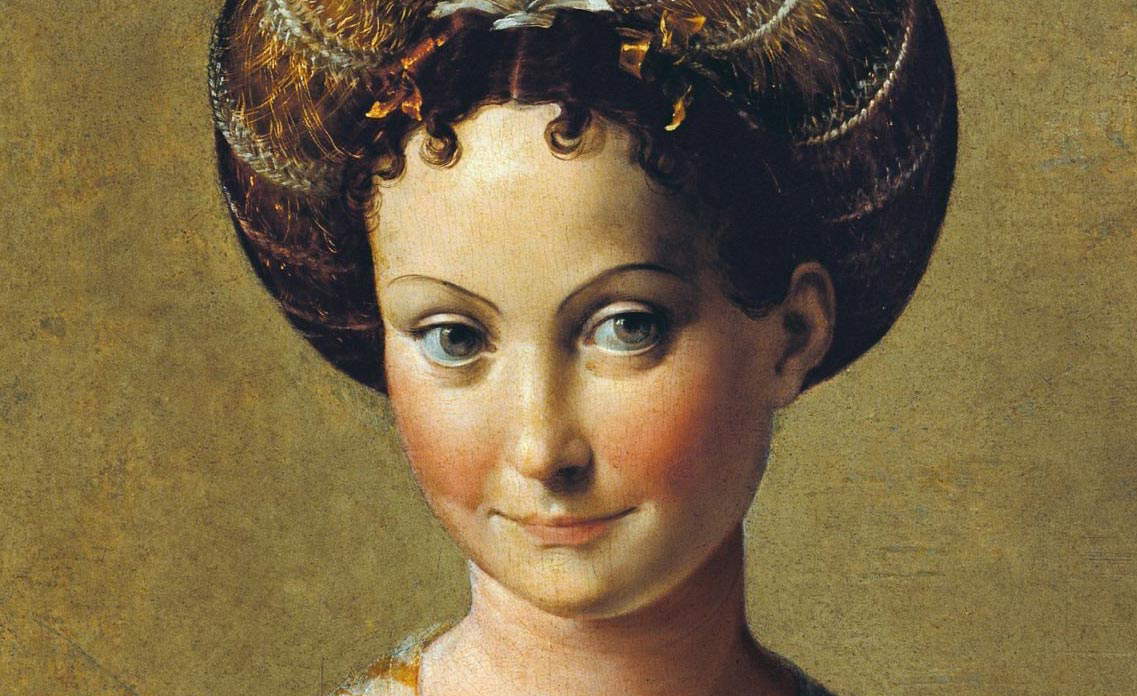 |
| Parmigianino, Turkish Slave Girl, detail of the face |
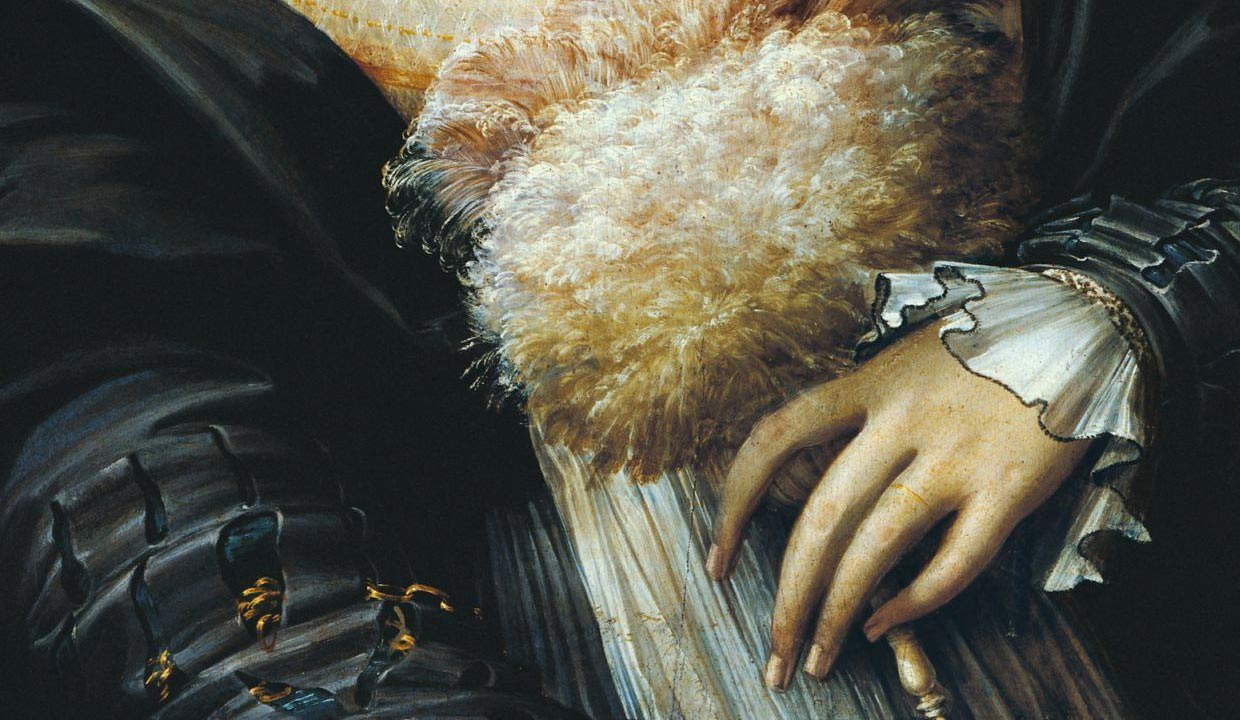 |
| Parmigianino, Turkish Slave Girl, detail of the hands |
Albeit succinctly, the 1704 inventory notation provides a description of the Turkish Slave Girl. The painting’s protagonist appears to be wearing a turban, but in fact her hair is combed into a flounced style, a type of hairstyle much in use among gentlewomen in the 1620s and 1530s, especially in the Po Valley area (we see some, very similar ones, in the famous Portrait of Isabella d’Este painted by Titian around 1534 and now in the Kunsthistorisches Museum in Vienna, in the equally famous Portrait of Lucina Brembati, by Lorenzo Lotto in 1518, and in Cavazzola’s Portrait of a Gentlewoman, the latter both in the Accademia Carrara in Bergamo, in Bernardino Licinio’s Portrait of a Gentlewoman now in the Prado and also painted around the same time, between 1525 and 1530, and also in another portrait by Parmigianino, the one thought to depict Countess Gozzadini). The balzo was achieved by using a metal net over which hair was tied, pulled back, and then covered with silk and adorned with ribbons, flowers or precious stones: Parmigianino’s young woman wears a cameo with the image of a winged horse. Far from exoticism, then: the Parmigianino painter’s girl has her hair combed according to a fashion of the Emilian and Lombard noblewomen of the time. From the headdress then sprout a few curls divided by a parting, according to a female hairstyle in vogue at Parmigianino’s time. The complexion is pale, enlivened only on the cheeks, the eyes large, viscous, and luminous. The girl is clad in a luxurious midnight-blue dress with puffed sleeves embroidered with gold threads. On her shoulders, the young woman wears a white and gold shawl, and in her hands she holds a “rosta,” or fan, made of soft white ostrich feathers.
While critics are unanimous in assigning the Turkish Slave Girl to Parmigianino, the same is not true for the dating, since there are those who refer the portrait to Francesco Mazzola’s Bologna period (i.e., between 1527 and 1530), or to the period of his return to Parma, when the painter, as Giorgio Vasari attests in his Lives, “so many years out of the country and much experimented in art, without having made, however, any purchase of facultà , but only damici, he returned at last, to satisfy many friends and relatives, to Parma.” There would also be a drawing that could be related to the Turkish Slave Girl, at least according to English scholar Arthur Ewart Popham who, in 1971, speculated that sheet 6523 in the Cabinet des Dessins of the Louvre might be a study for the girl’s head (lacking a leap in the drawing). The lively smile of the woman depicted and the shading of her face have striking similarities with the Turkish Slave Girl. Then there is a Study of a Woman with a Leap preserved at the École des Beaux-Arts in Paris, also in sanguine like the one in the Louvre, and traced back to the Turkish S lave by Emmanuelle Brugerolles in 2011: however, it is a drawing that appears much more schematic and, above all, decidedly more detached than the painting, not to mention the fact that the facial features themselves are radically different.
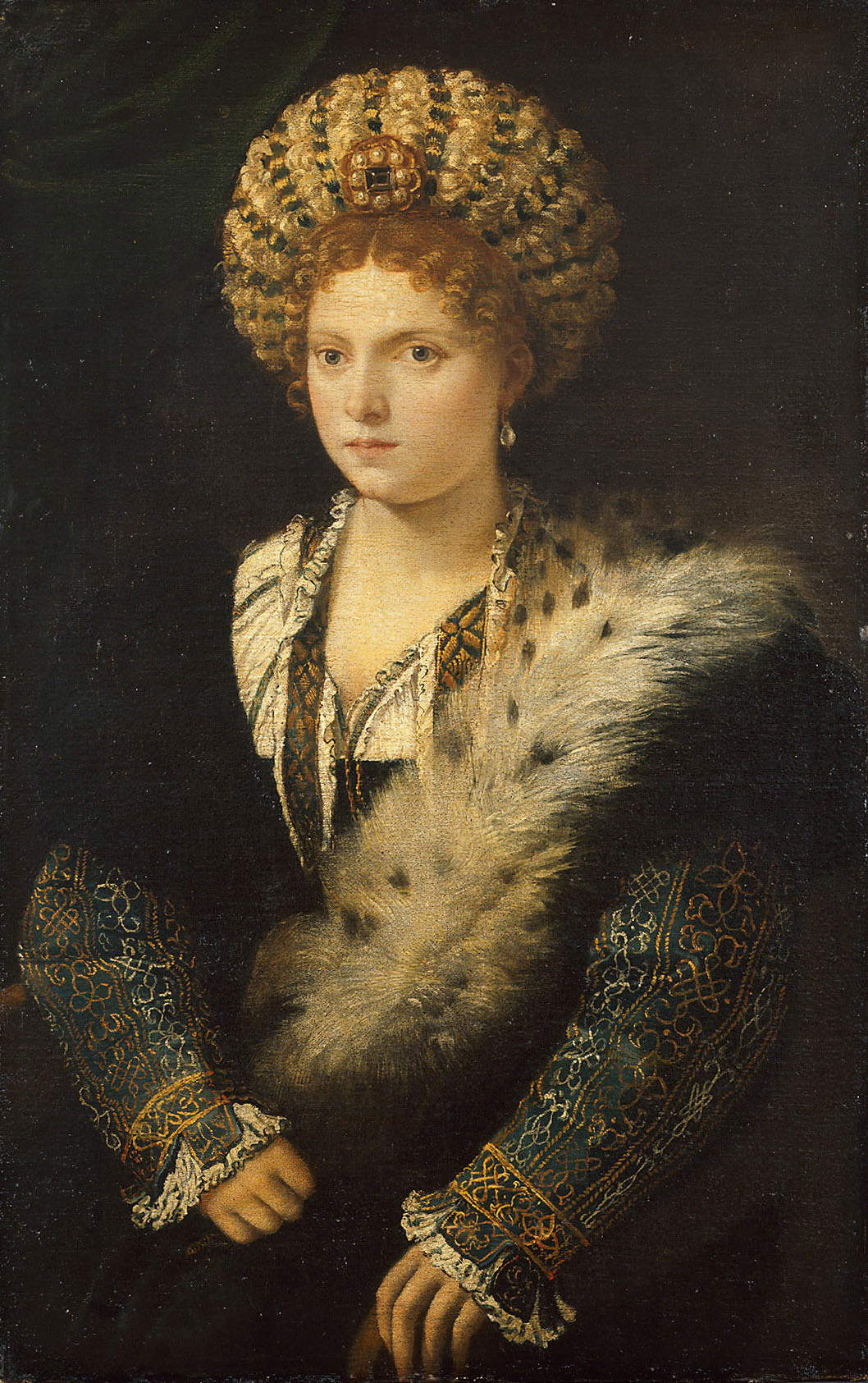 |
| Titian, Portrait of Isabella d’Este (1534-1536; oil on canvas, 102.4 x 64.7 cm; Vienna, Kunsthistorisches Museum) |
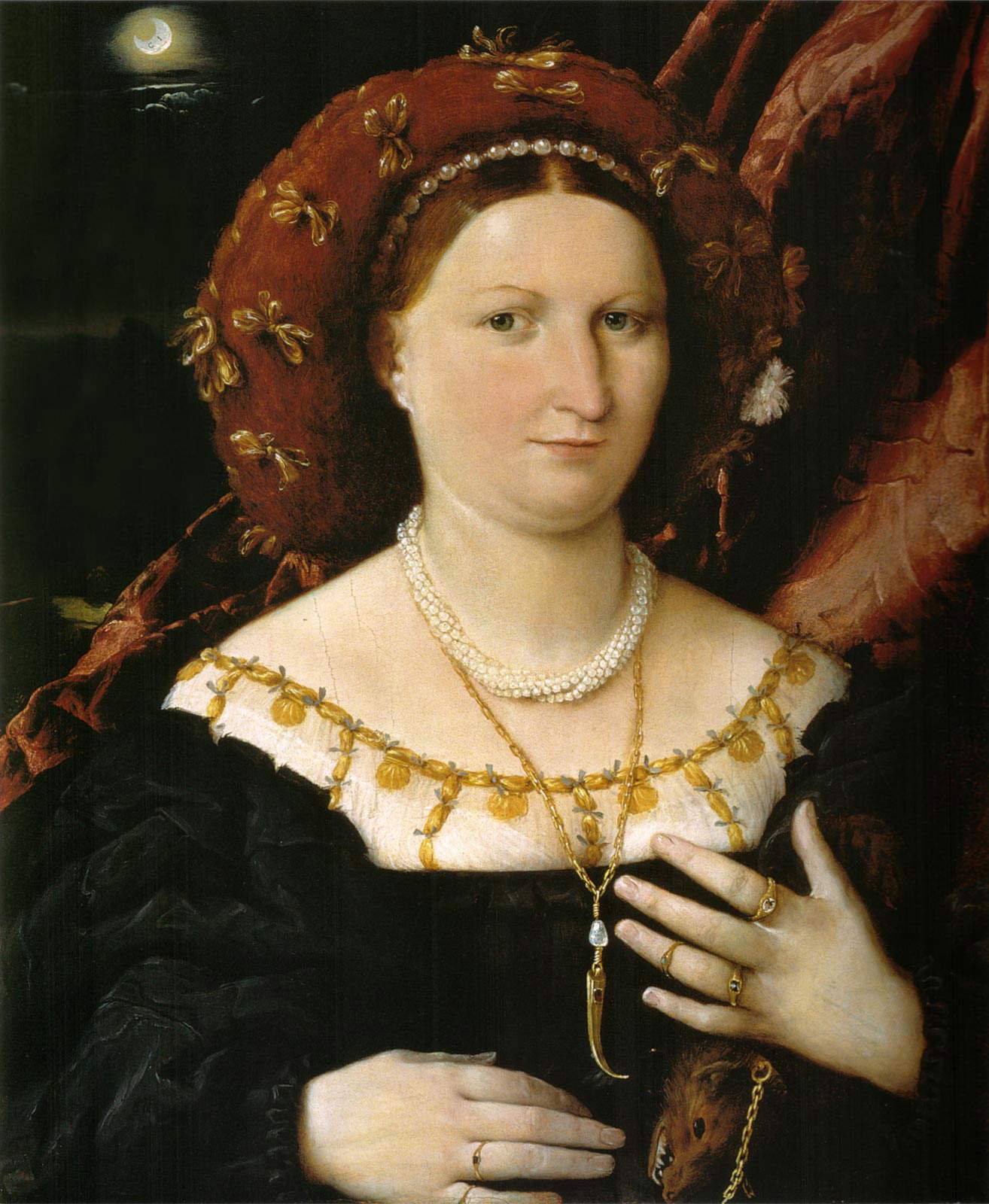 |
| Lorenzo Lotto, Portrait of Lucina Brembati (c. 1518-1523; oil on panel, 52.6 x 44.8 cm; Bergamo, Accademia Carrara) |
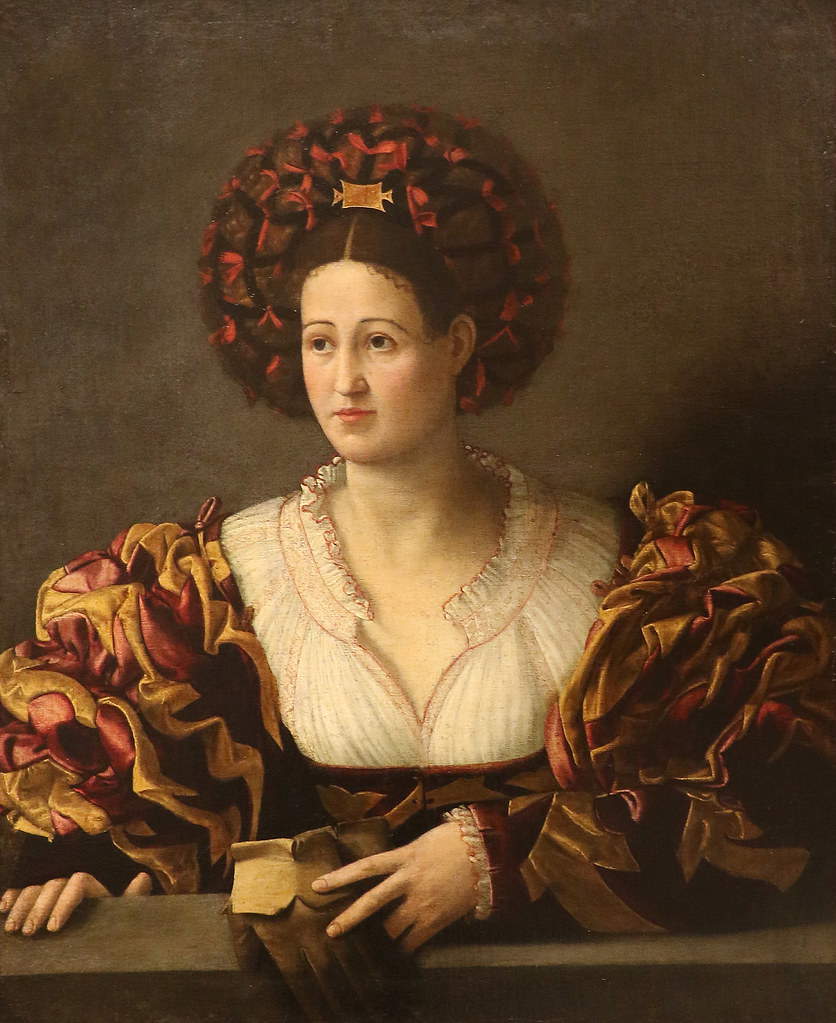 |
| Paolo Morando known as il Cavazzola, Portrait of a Gentlewoman (c. 1520; oil on canvas, 96.4 x 74.2 cm; Bergamo, Accademia Carrara) |
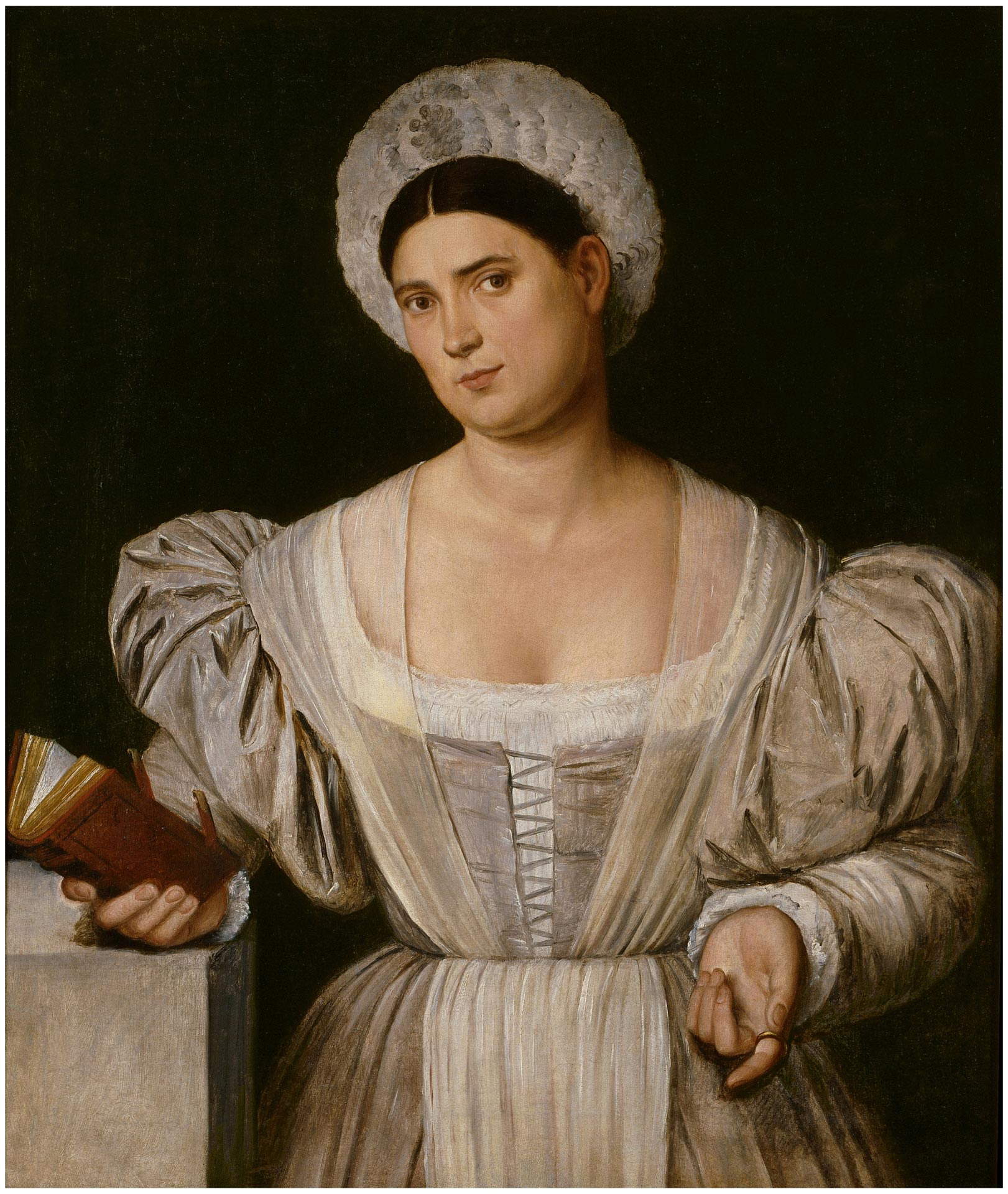 |
| Bernardino Licinio, Portrait of a Gentlewoman (c. 1525-1530; oil on canvas, 98 x 70 cm; Madrid, Prado) |
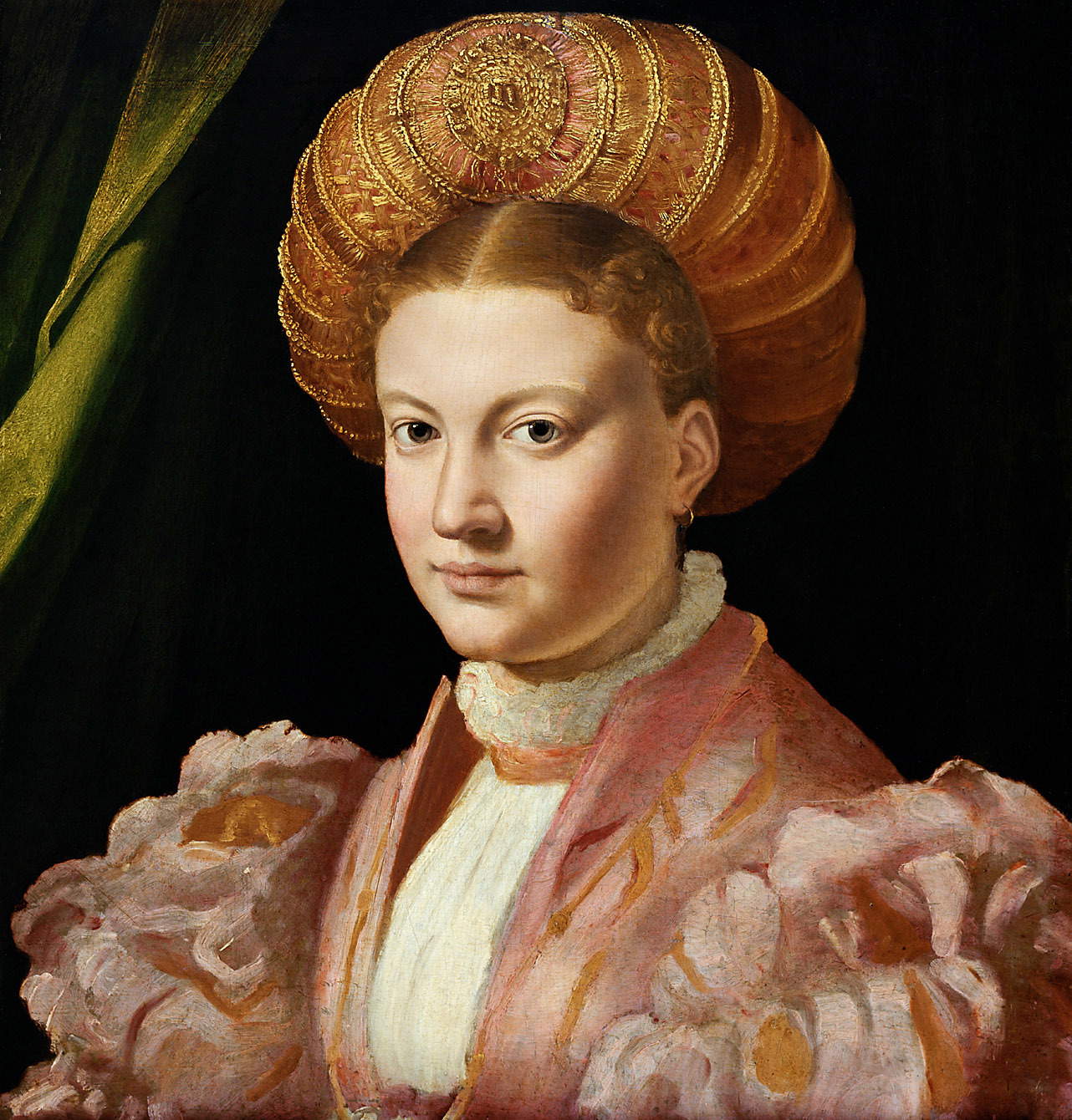 |
| Parmigianino, Portrait of a Gentlewoman (Costanza Rangoni Countess Gozzadini?) (c. 1530; oil on panel, 48.5 x 46.5 cm; Vienna, Kunsthistorisches Museum) |
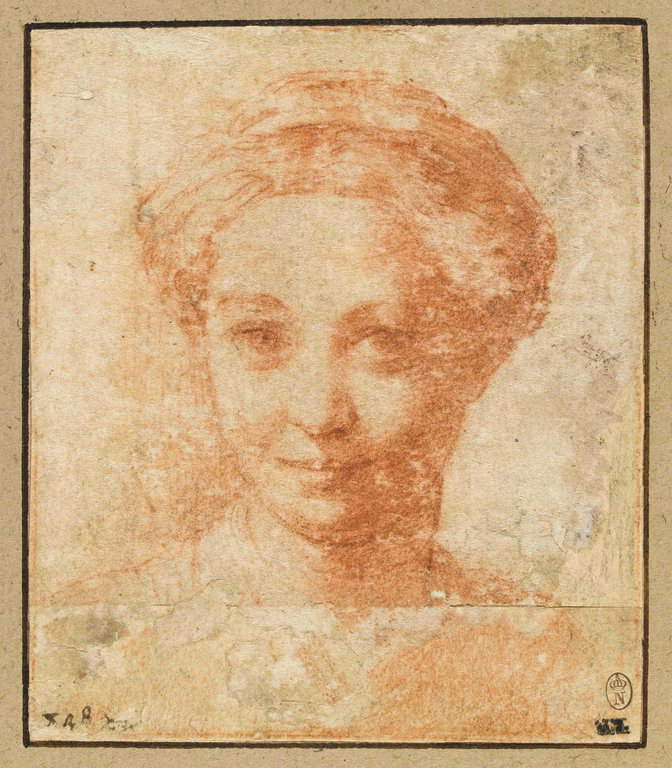 |
| Parmigianino, Study for Female Face (c. 1530-1534; sanguine on paper, 101 x 87 mm; Paris, Louvre, Cabinet des Dessins, inv. 6523) |
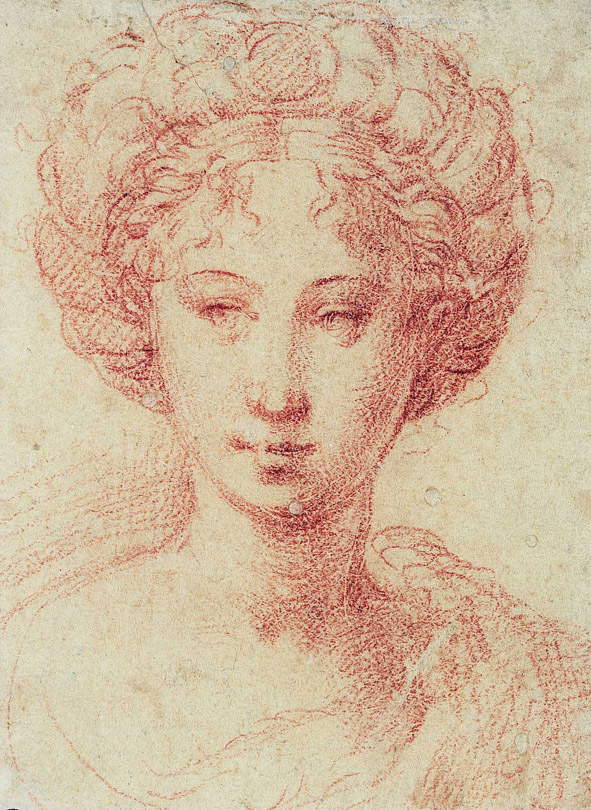 |
| Parmigianino, Study for Female Head (c. 1530-1534; sanguine on paper, 103 x 76 mm; Paris, École Nationale Supérieure des Beaux-Arts) |
The latest orientations of critics favor a placement in the second Parmesan period, that of the disconsolate return to Parma to be placed between the spring of 1530 and that of the following year: a period that, at first, was particularly happy for the artist, who in his hometown obtained the important commission for the frescoes of the basilica of Santa Maria della Steccata (which we can count among his greatest masterpieces) and, above all, began to execute numerous portraits. The thesis of dating to the Parma period is supported by one of the most distinguished Parmigianino scholars, David Ekserdjian, who proposed it in his 2006 monograph and reiterated verbatim in 2016 on the occasion of the exhibition Correggio and Parmigianino. Art in Parma in the Sixteenth Century, held at the Scuderie del Quirinale. The argument, which might seem idle, is actually useful in exploring the work’s eventual destination. Indeed, Ekserdjian writes that Parmigianino, upon returning to his hometown, “continued to paint portraits, none of which, however, were apparently known to Vasari. It is not easy to place these works in a definitive chronological sequence, but they all show a consistent tendency to idealize and stylize features.” Similar works in conception belong to this period, such as the Pallas Athena now in Buckingham Palace and the celebrated Antea in the Museo Nazionale di Capodimonte in Naples. The latter, in particular, shares with the Turkish Slave the bizarre titling that has nothing to do with the subject, since there is no good reason to believe that the Neapolitan painting represents the courtesan Antea, who practiced in 16th-century Rome, who is mentioned in some literary works (the Life of Benvenuto Cellini and some writings by Pietro Aretino) and who in an account by a seventeenth-century art writer, Giacomo Barri (the work is entitled Viaggio pittoresco d’Italia), is mentioned, without reason given, as Parmigianino’s mistress. In all likelihood, theAntea is actually an idealized portrait.
There have long been questions about the possible identity of the Turkish Slave Girl, but no serious conclusions could be reached. One of the last attempts to trace the young woman back to a real person is the work of scholar Anna De Rossi, among the very few to take literally the title by which the painting is known: according to De Rossi, in fact, the work would depict the noblewoman Giulia Gonzaga (Gazzuolo, 1513 - Naples, 1566), countess of Fondi, a town on the coast of southern Lazio that in 1534 was sacked by the pirate Barbarossa (Khayr al-D?n; Mytilene, 1478 - Constantinople, 1546), who also attempted to kidnap Giulia, who managed, however, to escape her adversary at night (hence why the painting would go down in history by its curious title). According to De Rossi it could be a painting executed to celebrate the marriage between Giulia and Vespasiano Colonna (the ring that the Turkish Slave Girl wears could identify her as a young bride), but this hypothesis would clash with all the critics’ positions on dating, since it would be necessary to imagine the painting executed within 1528 (the year in which Colonna died, after just two years of marriage to Giulia Gonzaga, who married him when she was thirteen). Moreover, the similarities with other known portraits of the young Mantuan are very tenuous (not to mention the fact that the Turkish Slave does not seem to be the image of a teenager, such as Giulia must have been at the time she would have lent her face for the work).
Other scholars have focused instead on the winged horse decorating the leap (probably an image of the mythological Pegasus). In this case, there are two lines of interpretation: one focusing on the winged horse as an allegorical reference, the other taking it as a heraldic symbol. In the first case, one might think of the Pegasus as a reference to poetry: the famous winged horse was in fact, in the humanistic sphere, a symbol of this art, due to the fact that, according to mythology, Pegasus, with his hoof, had caused a spring called Hippocrates to spring from Mount Helicon, around which the Muses would take to gather. In a medal by the Carrarese sculptor Danese Cattaneo(Colonnata, 1512 - Padua, 1572), in which the man of letters Pietro Bembo (Venice, 1470 - Rome, 1547) is effigyed, the reverse is occupied precisely by the figure of Pegasus, symbolizing the activity of the character depicted on the other side. It has therefore been suggested that the Turkish Slave may depict a poetess (perhaps Veronica Gambara), but again with very tenuous footholds: if it really was Veronica Gambara, it must be emphasized that it would have to be admitted that the Countess of Correggio would have asked Parmigianino to rejuvenate her (given that in 1530 she was a woman of almost fifty), and that such a mischievous look would have been hardly appropriate for a woman of her rank (without calculating the fact that the conspicuous reddening of her cheeks would have made her mistake for a courtesan). Instead, in the second case, attempts were made to try to identify the Turkish Slave as a woman belonging to the Baiardo or Cavalli families (both have the animal in their coats of arms). However, David Ekserdjian has observed that, if it were a member of the Baiardo family, it would not have been difficult for those who compiled the inventories to indicate the identity of the effigy, which is why the Pegasus could, if anything, be a reference to the identity of the patron rather than that of the subject.
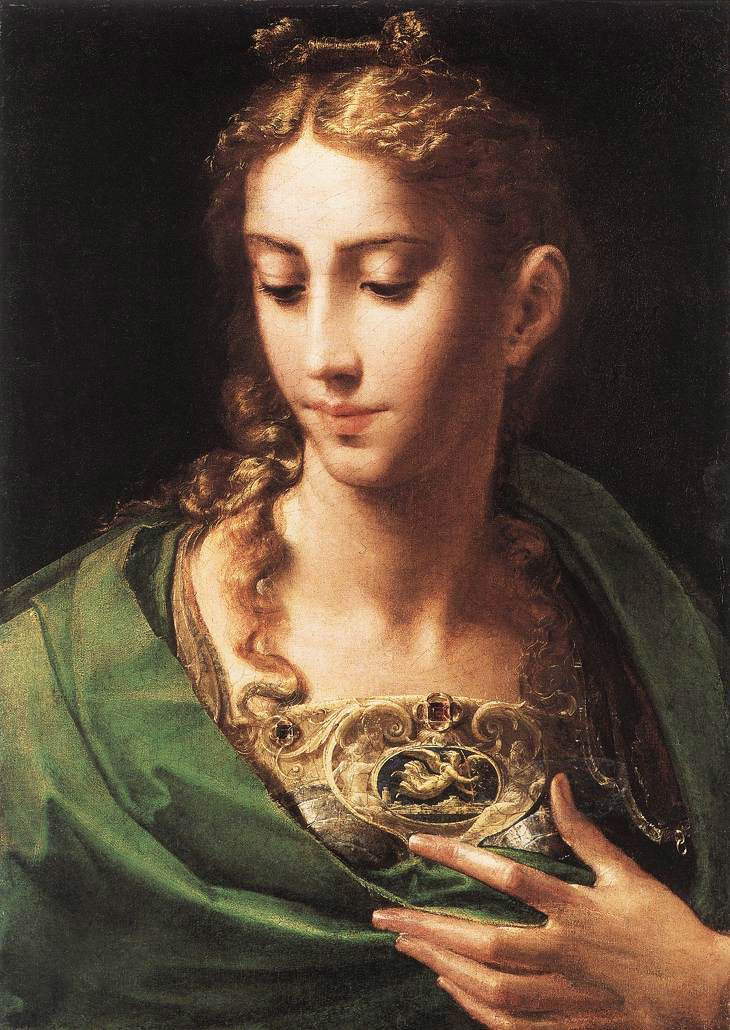 |
| Parmigianino, Pallas (c. 1530-1533; oil on canvas, 63.5 x 45.6 cm; Hampton Court, Royal Collection) |
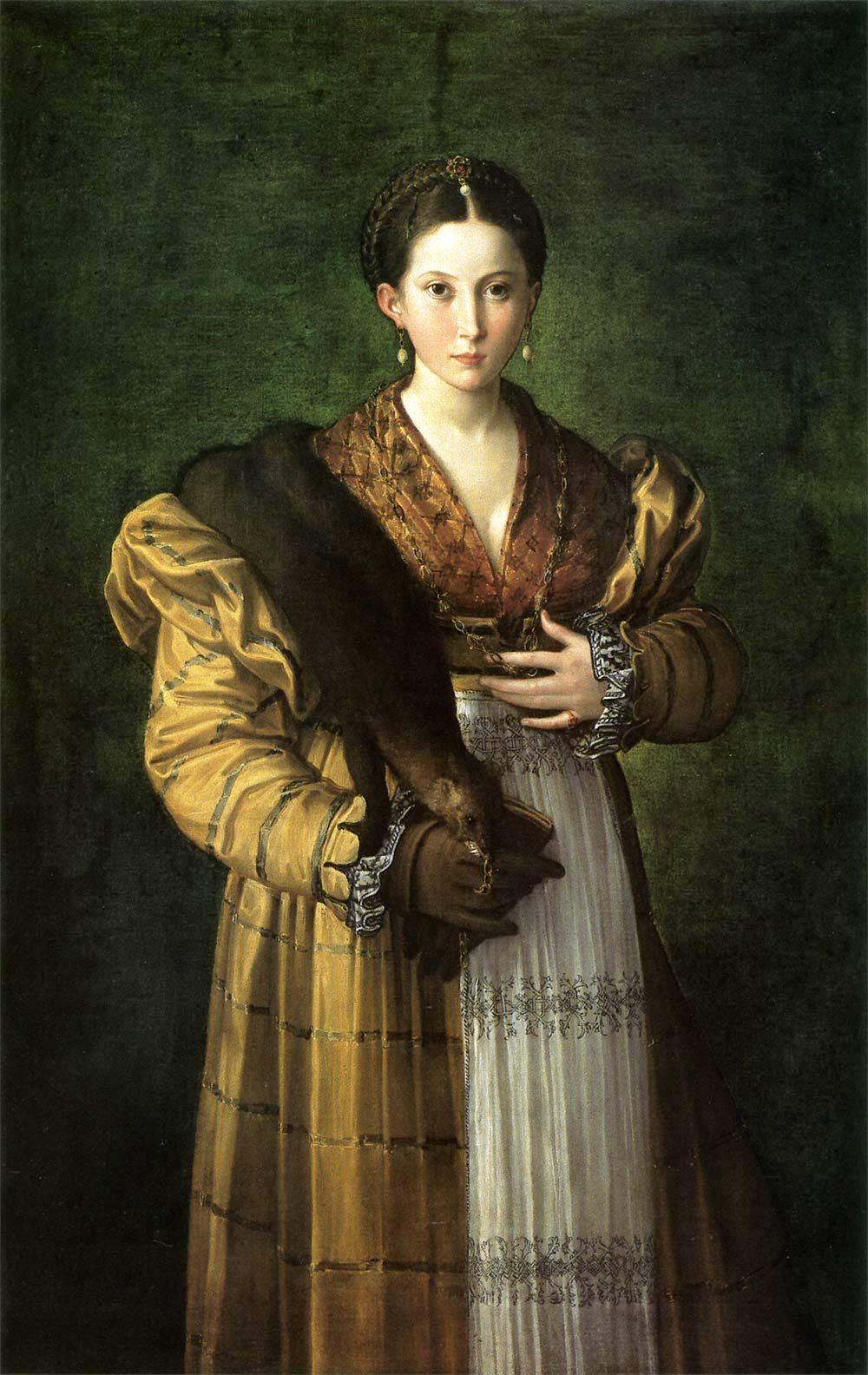 |
| Parmigianino, Antea (c. 1530; oil on canvas, 135 x 88; Naples, Museo Nazionale di Capodimonte) |
 |
| Cerchia di Sebastiano del Piombo, Portrait of Giulia Gonzaga (16th century; oil on panel, 22.9 x 16.5 cm; Private Collection) |
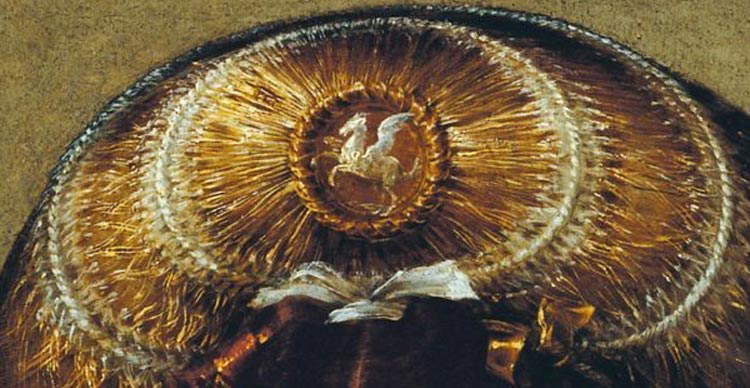 |
| Parmigianino, Turkish Slave, detail of the Pegasus |
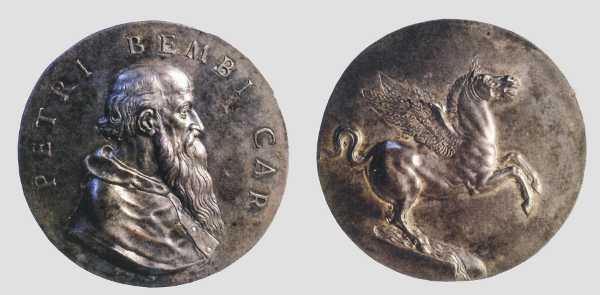 |
| Danese Cattaneo, Medal of Pietro Bembo (1547-1548; silver casting, diameter 5.6 cm; Florence, Museo Nazionale del Bargello) |
In fact, the Turkish Slave may simply not be a real person who existed: the famous title of the painting, Ekserdjian wrote, “could perhaps suggest the apparently justified intuition that it was a depiction of beauty intended for male enjoyment rather than a portrait commissioned by the effigy or her family.” The scholar adds that "it is always best to be cautious when talking about verisimilitude in Renaissance portraiture, given the impossibility of ascertaining the real appearance of the models, but it is hard not to think that the way the Turkish Slave ’s shoulders slope down until they almost disappear is conceived as a sign of beauty. In any case, the effect created is one of unusual delicacy and fragility, with the elaborate outline of the figure outlined against the pale neutral background."
An ideal portrait, then, that simply speaks of beauty and poetry, not intended to give a face to a real model, but to create a poetic depiction of a beautiful young woman. It is interesting to note that Parmigianino was on close terms with the Baiardi family: he was a friend of Cavalier Francesco Baiardi, who had Cupid Making the Bow in his collections, and at the end of his own career, in December 1534, he was commissioned by the latter’s sister, Elena Baiardi Tagliaferri, to paint a work that later became an icon itself of Parmigianino art, the celebrated Madonna with the Long Neck, perhaps the most famous painting by the Parma artist. Since we know that the grandfather of the two, Andrea Baiardi, was also an amateur poet, the hypothesis of a refined portrait fitting into the cultural climate of sixteenth-century Parma, where the Pegasus refers us to one of the main “norms” of sixteenth-century painting, might not be so far-fetched, that of the Horatian motto ut pictura poësis, and consequently the Turkish Slave could be nothing more than the ideal image of an artistic and literary temperament, a kind of translation into images of the ideas of the intellectual circles of Emilia at the time. What is certain is that the Turkish S lave remains one of the most elegant portraits of the entire sixteenth century, an image balanced between the delicacy of the figure, the detachment from the light background and the brightness of the young woman’s dress, as well as, as scholar Paola Rossi has written, “one of the most significant examples of Parmesan portraiture,” which “reveals the expressive originality achieved even in that field by the Parma master.”
Reference bibliography
- David Ekserdjian (ed.), Correggio and Parmigianino. Art in Parma in the Sixteenth Century, exhibition catalog (Rome, Scuderie del Quirinale, March 12 to June 26, 2016), Silvana Editoriale, 2016
- Aimee Ng, The poetry of Parmigianino’s Schiava Turca, exhibition catalog (New York, Frick Collection, May 13 to July 20, 2014 and San Francisco, Legion of Honour Fine Arts Museums, July 25 to October 5, 2014), Frick Collection, 2014
- Lucia Fornari Schianchi, Sylvia Ferino-Pagden, Parmigianino and European Mannerism, proceedings of the international study conference (Parma, June 13-15, 2002), Silvana Editoriale, 2003
- Vittorio Sgarbi, Parmigianino, Rizzoli, 2003
- Mary Vaccaro, Parmigianino, the paintings, Allemandi, 2002
- Maria Cristina Chiusa, Parmigianino, Electa, 2001
- Paola Rossi, The Complete Works of Parmigianino, Rizzoli, 1980
- Augusta Ghidiglia Quintavalle, La “Schiava Turca” del Parmigianino in Bollettino d’Arte, 49, 4, 3 (July-September 1964), pp.251-252
Warning: the translation into English of the original Italian article was created using automatic tools.
We undertake to review all articles, but we do not guarantee the total absence of inaccuracies in the translation due to the program. You can
find the original by clicking on the ITA button. If you find any mistake,please contact us.












































